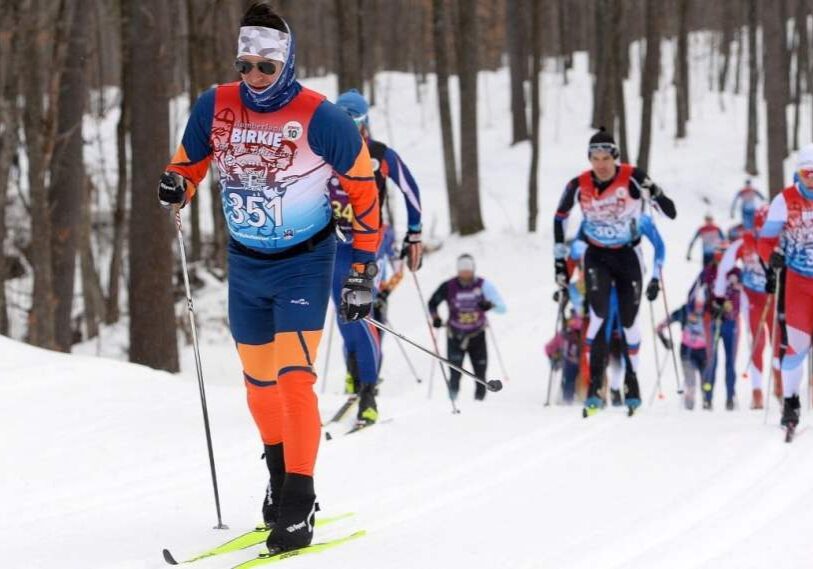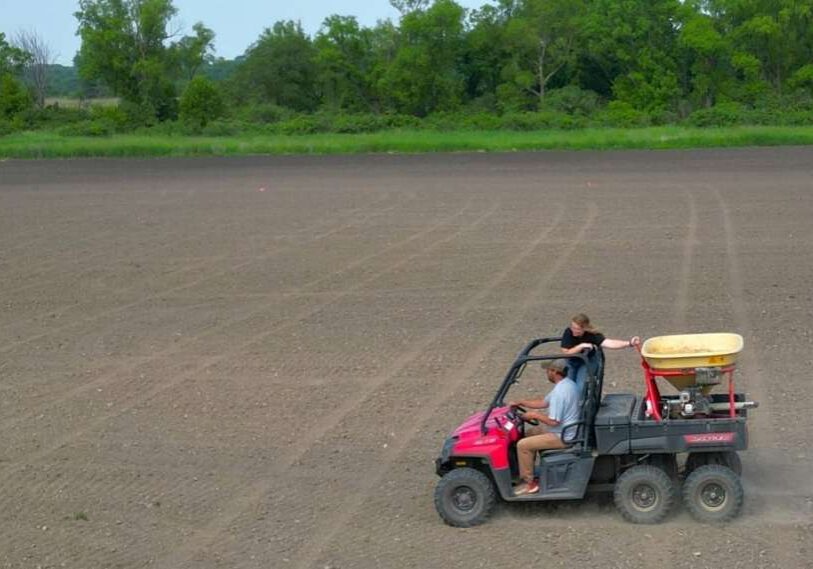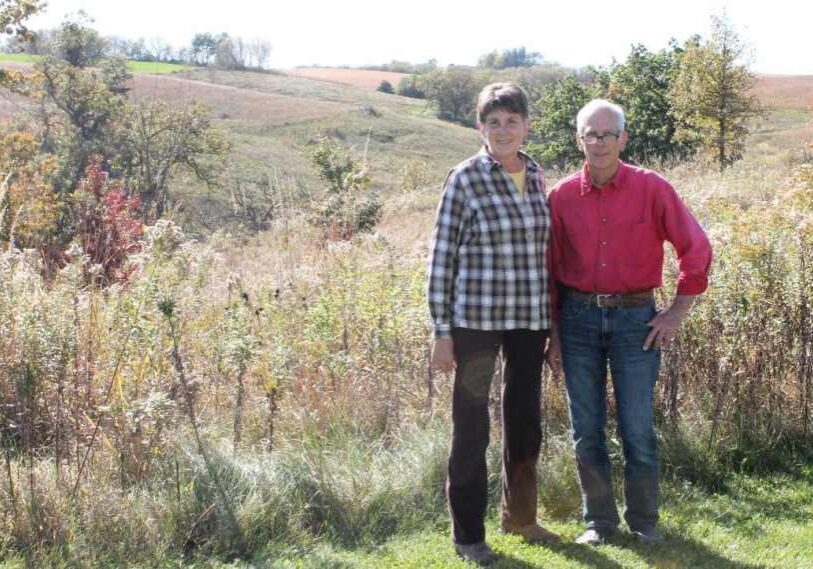Hundreds of Shrubs to Protect Vesta Creek Streambank
Restoration project volunteers help trout stream weather climate change and erosion

PREBLE TOWNSHIP, FILLMORE COUNTY — In late May, we made the two-thirds mile walk down the old trail-road along remote Vesta Creek, southeast of Choice, so we could help give nature a boost.
Ten of us, all from various conservation groups, were there to begin planting 5,000 shrub seedlings along a restored section of this small trout stream in Choice Wildlife Management Area between Rushford and Mabel.
As they take hold, the shrubs will help stabilize the bank after it was sloped back last fall so the stream could again have a floodplain during high water.
These 5,000 plants, however, weren’t just any seedlings. They were from an Iowa Department of Natural Resources nursery and were chosen because, while they are the same kinds of plants found in southeastern Minnesota blufflands, they are a different ecotype.

Seedlings were first placed in buckets of water to wet the roots. (Photo by John Weiss)
Adapting for climate change, planning for the future
Ecotypes are plants or animals that are the same species but have been adapted for specific areas. That difference is critical, according to Kaitlyn Bottorff, Driftless area restoration specialist with the The Nature Conservancy (TNC) that is coordinating much of the work.
One example of a different ecotype related to this site is heritage brook trout swimming in Vesta Creek. While brook trout from other places were put into southeast streams many years ago, research has shown the heritage trout, and now the Minnesota Driftless trout made up of heritage fish, do better. This is probably because they are native (but no one is sure because we don’t have genetics from 150 years ago). They may look alike but heritage survive better.
The hope is that because of climate change, plants such as elderberry or some willow from maybe 50- to 100-miles south will fare better than plants from this area, Bottorff said.
With climate change comes the need for climate adaptation, she said. “We are seeing things get a little warmer, a little wetter.”
Iowa ecotypes will bring different genetics, “they will be better adapted to the changing conditions and will be able to thrive long into the future,” she said. “There are slight differences in how the plants are adapting to their environment.”
For example, Bottorff explains, maybe the Iowa plants will flower a bit earlier, which would match the warming springs in southeastern Minnesota’s blufflands.

Restoration specialist Kaitlynn Bottorff shows seedlings with their long roots, needing to be pruned before planting. (Photo by John Weiss)
Yes, nature does such adapting, she said. But here’s the crucial detail – nature does it very slowly, while climate change is happening very fast.
“That’s the thing about climate change that we are really concerned about, the rate of change. We have not experienced this change within the climate and within the species,” Bottorff said.
“Give it enough time and these sorts of things will likely occur naturally.” Waiting for nature, however, could mean “collateral damage” such as invasive species coming in. “There are a lot of unknowns.”
Growing with nature
The Nature Conservancy is trying to act not out of fear, but hope, she said. It’s trying to be proactive just as it’s trying to do the same with flat and goat prairies and forests, she explained.
The work is the first such project TNC has done in the Driftless area of Minnesota. But it’s been doing a lot of other work in the region including on the goat prairie overlooking Vesta Creek.

Once in the ground, each planting had soil firmly pushed back onto the seedling. (Photo by John Weiss)
“The Driftless area is a really special and unique part of the state,” Bottorff pointed out. “We have a lot of biodiversity here in the Driftless. We also have some threats to our native plant communities that we want to help preserve.”
Many other groups, including the Minnesota Department of Natural Resources, are also very active, she said.
Everyone can help with this project
Not only big groups can help, Bottorff said. Individuals with some land where they want to plant flowers or shrubs might look for the more southerly ecotypes, she explained.
“That’s the really great thing, there is a lot that individuals can do to help with this,” she said. “There are so many great things you can do to help.”
The way we were helping that day was people from TNC, Trout Unlimited (TU) and even the Ruffed Grouse Society walked down that road to where the heavy stream-shaping work was done last fall and where 5,000 seedlings awaited.
One of the volunteers was Bill Brant who is from Kansas City but is a member of the Hiawatha TU chapter based in Rochester. He said his partner comes to Rochester Mayo Clinic for treatment and he read about the Driftless and its great trout fishing so he comes to the region regularly. When he read about the need for volunteers, he said yes.

Planting volunteer Bill Brant opens holes in jute for others to place planting bars. (Photo by John Weiss)
Jay Kim who lives upstream of where work was to be done and is TNC board chairman for Minnesota, North and South Dakota, also joined in the effort. Others did the work as part of their jobs with TNC or other agencies and appreciated a day out of the office.
At the stream, Chris Lenhart, a University of Minnesota research professor in the Department of Bioproducts and Biosystems Engineering, who designed the project, said that what was a meandering stream was probably straightened many years ago to help with farming. But because of poor land use, many tons of farmland were washed into the stream, building up steep banks so Vesta Creek was trapped within its banks.

Planting bars often needed a good jump onto them to get deep enough. (Photo by John Weiss)
In many other habitat improvements, the stream gets a meander and the bank gets rock or wood to stabilize it. That, however, requires maintenance. Work last fall help shape the stream back, but left it straight; the goal is to let it naturally add meanders where it wants, to let nature do it so less work will be needed in the future.
We planted only floodplain shrubs that day, first forcing open holes in the jute webbing put down to hold the ground in place, then someone would use a special tool to open a hole. Shrubs were placed in, but they couldn’t have roots too long or they were pruned. It took a while but we got it down to where we could do it quickly.
Eventually, we planted maybe 500 to 600 shrubs and Bottorff was happy. Another work day was scheduled for the next day and after that, TNC work crews, including some people who were there that day, would finish the work.
Many hands make light work
We got a great day for the work – overcast, cool but not cold, the breeze blocked by the bluffs. The only thing that would have made it better was some rain a few days before to soften the floodplain soil.

Seedlings were planted a few feet away from each other in anticipation of nearly half not surviving. (Photo by John Weiss)
When done, TNC’s Kaitlyn Bottorff expects only maybe 30- to 50-percent will survive. Some will not take root well, others will be eaten by deer or rabbits.
The better news, however, is that some are expected to survive now and last well into the future when the climate is expected to be warmer and wetter.
And a healthier Vesta Creek and its trout population will be the happy benefactors.






